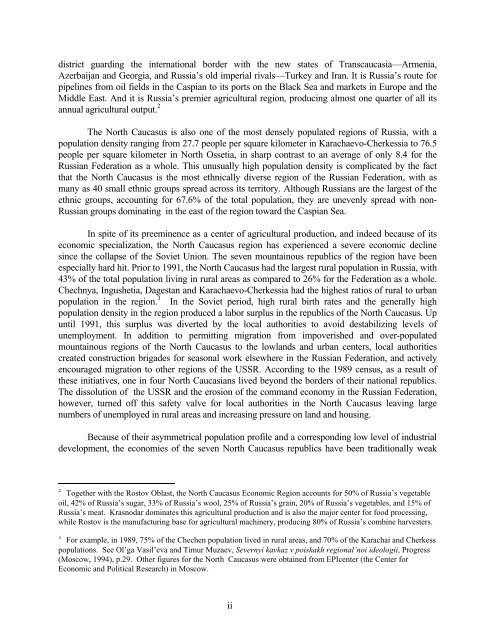RUSSIA'S TINDERBOX - Belfer Center for Science and International ...
RUSSIA'S TINDERBOX - Belfer Center for Science and International ...
RUSSIA'S TINDERBOX - Belfer Center for Science and International ...
Create successful ePaper yourself
Turn your PDF publications into a flip-book with our unique Google optimized e-Paper software.
district guarding the international border with the new states of Transcaucasia—Armenia,<br />
Azerbaijan <strong>and</strong> Georgia, <strong>and</strong> Russia’s old imperial rivals—Turkey <strong>and</strong> Iran. It is Russia’s route <strong>for</strong><br />
pipelines from oil fields in the Caspian to its ports on the Black Sea <strong>and</strong> markets in Europe <strong>and</strong> the<br />
Middle East. And it is Russia’s premier agricultural region, producing almost one quarter of all its<br />
annual agricultural output. 2<br />
The North Caucasus is also one of the most densely populated regions of Russia, with a<br />
population density ranging from 27.7 people per square kilometer in Karachaevo-Cherkessia to 76.5<br />
people per square kilometer in North Ossetia, in sharp contrast to an average of only 8.4 <strong>for</strong> the<br />
Russian Federation as a whole. This unusually high population density is complicated by the fact<br />
that the North Caucasus is the most ethnically diverse region of the Russian Federation, with as<br />
many as 40 small ethnic groups spread across its territory. Although Russians are the largest of the<br />
ethnic groups, accounting <strong>for</strong> 67.6% of the total population, they are unevenly spread with non-<br />
Russian groups dominating in the east of the region toward the Caspian Sea.<br />
In spite of its preeminence as a center of agricultural production, <strong>and</strong> indeed because of its<br />
economic specialization, the North Caucasus region has experienced a severe economic decline<br />
since the collapse of the Soviet Union. The seven mountainous republics of the region have been<br />
especially hard hit. Prior to 1991, the North Caucasus had the largest rural population in Russia, with<br />
43% of the total population living in rural areas as compared to 26% <strong>for</strong> the Federation as a whole.<br />
Chechnya, Ingushetia, Dagestan <strong>and</strong> Karachaevo-Cherkessia had the highest ratios of rural to urban<br />
population in the region. 3 In the Soviet period, high rural birth rates <strong>and</strong> the generally high<br />
population density in the region produced a labor surplus in the republics of the North Caucasus. Up<br />
until 1991, this surplus was diverted by the local authorities to avoid destabilizing levels of<br />
unemployment. In addition to permitting migration from impoverished <strong>and</strong> over-populated<br />
mountainous regions of the North Caucasus to the lowl<strong>and</strong>s <strong>and</strong> urban centers, local authorities<br />
created construction brigades <strong>for</strong> seasonal work elsewhere in the Russian Federation, <strong>and</strong> actively<br />
encouraged migration to other regions of the USSR. According to the 1989 census, as a result of<br />
these initiatives, one in four North Caucasians lived beyond the borders of their national republics.<br />
The dissolution of the USSR <strong>and</strong> the erosion of the comm<strong>and</strong> economy in the Russian Federation,<br />
however, turned off this safety valve <strong>for</strong> local authorities in the North Caucasus leaving large<br />
numbers of unemployed in rural areas <strong>and</strong> increasing pressure on l<strong>and</strong> <strong>and</strong> housing.<br />
Because of their asymmetrical population profile <strong>and</strong> a corresponding low level of industrial<br />
development, the economies of the seven North Caucasus republics have been traditionally weak<br />
2 Together with the Rostov Oblast, the North Caucasus Economic Region accounts <strong>for</strong> 50% of Russia’s vegetable<br />
oil, 42% of Russia’s sugar, 33% of Russia’s wool, 25% of Russia’s grain, 20% of Russia’s vegetables, <strong>and</strong> 15% of<br />
Russia’s meat. Krasnodar dominates this agricultural production <strong>and</strong> is also the major center <strong>for</strong> food processing,<br />
while Rostov is the manufacturing base <strong>for</strong> agricultural machinery, producing 80% of Russia’s combine harvesters.<br />
3 For example, in 1989, 75% of the Chechen population lived in rural areas, <strong>and</strong> 70% of the Karachai <strong>and</strong> Cherkess<br />
populations. See Ol’ga Vasil’eva <strong>and</strong> Timur Muzaev, Severnyi kavkaz v poiskakh regional’noi ideologii, Progress<br />
(Moscow, 1994), p.29. Other figures <strong>for</strong> the North Caucasus were obtained from EPIcenter (the <strong>Center</strong> <strong>for</strong><br />
Economic <strong>and</strong> Political Research) in Moscow.<br />
ii
















